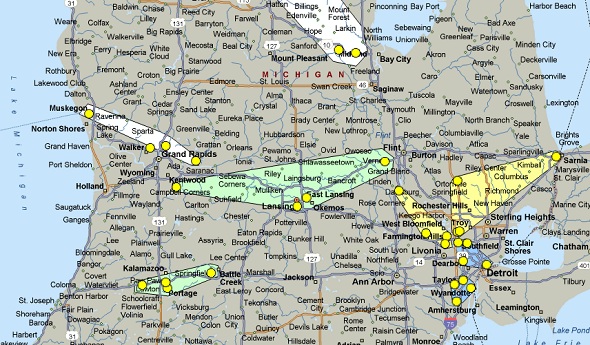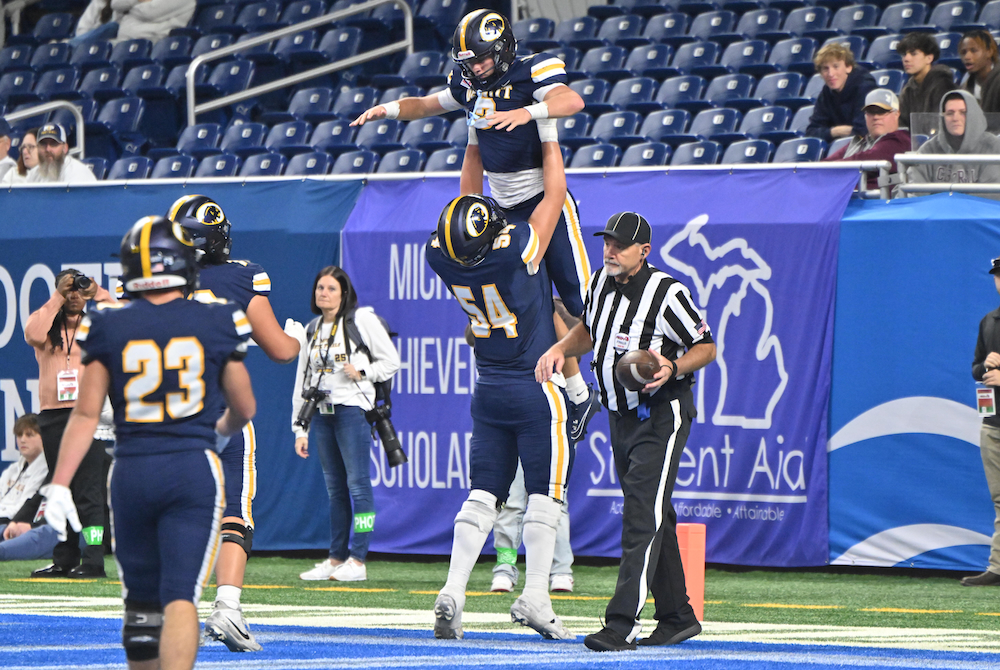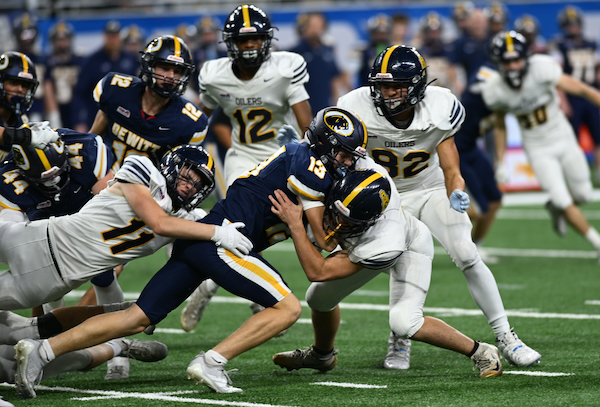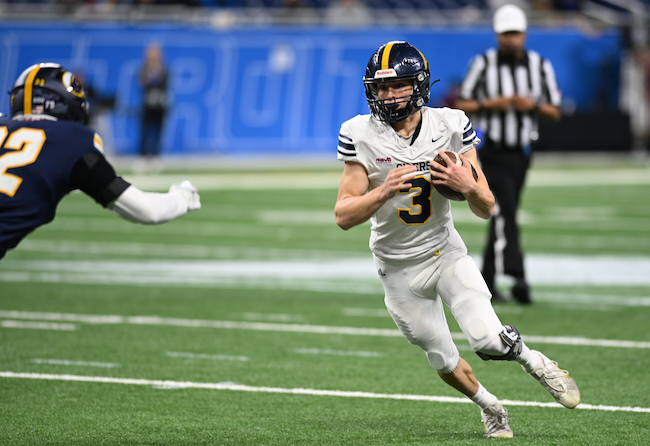
Inside Selection Sunday: Mapnalysis 2012
October 24, 2012
By Geoff Kimmerly
Second Half editor
Between double checking data for more than a third of our 626 football teams, and creating 136 first-round games for our most popular tournament, the morning of MHSAA football "Selection Sunday" is both one of the most exciting and nerve-wracking of the school year.
So for those scratching their heads the last few days over how we picked the brackets this season, I offer one question and one warning:
How would you have done so differently?
And before you answer, remember that moving the position of one school affects at least seven more – if not all 32 in that division.
This was the second year I was involved in the football selection process, which while appearing simple on its face actually is layered with hours of discussions, calculations, checking and re-checking, and anything else we at the MHSAA can do to make sure we’ve created the best tournament possible.
Simply put, it’s more than just drawing circles and calling them good.
Below are a brief description of what we do, the history behind the process, and some challenges we face each time we draw these brackets – including some examples of our toughest this time around.
The process
Our past: The MHSAA playoff structure – with 256 teams in eight divisions, and six wins equaling an automatic berth – debuted in 1999. An 8-player tournament was added in 2011, resulting in nine champions total when November is done.
That’s a long way from our start. The first playoffs were conducted in 1975 with four champions. Four more football classes were added in 1990 for a total of eight champions each fall. Through 1998, only 128 teams made the postseason, based on their playoff point averages within regions (four for each class) that were drawn before the beginning of the season. The drawing of Districts and Regions after the end of the regular season did not begin until the most recent playoff expansion.
In early years of the current process (or until the middle of the last decade), lines were drawn by hand. Dots representing qualifying schools were pasted on maps, one map for each division, and those maps were then covered by plastic sheets. Districts and Regionals literally were drawn with dry-erase markers.
Our present: After a late Saturday night tracking scores, we file in as the sun rises Sunday morning for a final round of gathering results we may still need (which can include making a few early a.m. calls to athletic directors). Then comes re-checking and triple-checking of enrollments, co-ops, some records and more before the numbers are crunched and the field of 256 is set.
Those teams are then split into eight equal divisions based on enrollment, and their locations are marked on digital maps that are projected on wall-size screens and then discussed by nearly half of the MHSAA staff plus a representative from the Michigan High School Football Coaches Association. Only the locations themselves are marked (by yellow dots) – not records, playoff points averages or names of the schools or towns. In fact, mentions of those are strictly prohibited. Records and playoff points are not part of the criteria. Matchups, rivalries, previous playoff pairings, etc. also DO NOT come into play.
Geography rules: Drawing Districts and Regionals is all about location. Travel distance and ease DO come into play. Yes, ease is important. Schools near the same major highway might be further from each other in mileage than other options but have a better trip. A good example this year is in Division 6, which has seven teams in the U.P. and the northern Lower Peninsula. That meant Shelby needed to be included with those teams to make eight, and left Montague to a District that includes Hemlock – more than halfway across the Lower Peninsula. But at least, in this case, much of that trip will be on one roadway, M-46.
There is certainly conversation about every possible option. The staff splits into two groups, each handling four divisions (plus one of the groups handles 8-player too), and then the entire committee comes together to view all nine maps. There wasn’t one division where the group as a whole said, “That looks great, what’s next?”
Observations and answers
A different ballgame: I was asked whatever happened to Districts, meaning teams opening with opponents nearby. Remember that with eight divisions and 32 teams in each, the difference between maximum and minimum enrollments for each division is smaller than it used to be with just four classes, and the probability of finding two schools in the same division next door to each other is lower. This is especially true for our smaller schools, and those pairings are more spread out. Division 7 provides an excellent example. Opponents Dansville and Ottawa Lake Whiteford are 84 miles apart. But in another option considered, Dansville would’ve played Gobles – and those two are separated by 114 miles.
Points still matter: And that means strength of schedule is a big factor. After Districts are drawn, playoff point average determines the home team for those two games and Regionals as well. There are five Districts in which the team with the best or second-best record did not get home games because those teams’ playoff point averages ranked third among the four teams in those brackets. A number of other Districts have 8-1 teams playing at other 8-1 teams. It’s true: there are times a school can’t help the opponents it plays, because of league affiliation perhaps, and they have no control over how an opponent does the rest of the season. But a Class B team playing in a league with Class D schools can’t expect to compare averages well against teams in their division who face similarly-sized opponents during the regular season.
No boating: This didn’t come up last season, but did twice Sunday. We had to decide if it was a better trip for teams in the thumb to go around Saginaw Bay to play northern opponents, or instead send teams a little bit south of the thumb but with a straight shots north. As the bird flies, the thumb teams were closer in some cases. But I’ve never heard of a team hopping into a boat to get to a playoff game.
The fifth wheels: The toughest lines to draw are around areas with five schools in the same division. Remember, Districts come in fours, and one dot affects the rest. The Grand Rapids area gave us tough calls because of five teams in Divisions 2 and 4. The same was true in the southwest corner in Division 7 and the southeast corner in Division 6. No matter how we circled it, one of those teams got stuck with a longer trip. This time, that group included Caledonia, Grand Rapids South Christian, Blissfield and Gobles.
It’s easy to say certain areas of these maps should’ve been drawn differently. But again, keep in mind a statewide view.
Some of our pairings could create gigantic matchups earlier in the playoffs than those teams might like. But again, who is to decide which teams are the best and which matchups most “gigantic” before they prove it on the field? At least three teams touted during this fall as potentially the best in the state this season didn’t even win their conference titles.
And as I said in this analysis last year, determining the playoff schedule is just one step in many. Nine MHSAA champions must survive until the end, regardless of which opponents they face along the way.
Their journeys begin Friday.

DeWitt Rewrites Finals Rushing Record Book in Completing Perfect Run
By
Scott DeCamp
Special for MHSAA.com
November 30, 2025
DETROIT – Traverse Moore had no idea about his record-setting day until the final moments of Sunday’s Division 3 Football Final.
“Honestly, I wasn’t worried about that. I was worried about getting the state championship win,” the shifty and speedy DeWitt senior quarterback said.
Moore and the Panthers left no doubt whatsoever. They ran into the history books.
On the strength of Moore’s Finals-record 397 rushing yards and four touchdowns, DeWitt rolled past Mount Pleasant, 54-20, in a battle of unbeatens at Ford Field. Moore’s effort shattered the record set in last year’s Division 6 Final by Jackson Lumen Christi’s Kadale Williams (314).
“We’ve been dreaming about it since fourth grade when we first started playing together. For this group of seniors to do that today, I couldn’t be happier,” said Moore, whose squad is the second from DeWitt to capture a Finals football title. The 2020 team won the first championship.
In DeWitt’s eighth championship game appearance, Moore scored three TDs in the opening quarter to tie a Finals record and help stake the Panthers to a 26-7 lead. The 6-foot, 195-pound Central Michigan University commit scored from 30 yards out barely two minutes into the contest, from 33 yards a little more than a minute later, and sprung free for a 74-yarder just past the midway point of the first quarter.
Moore’s fourth TD came on a 13-yard run barely three minutes into the second quarter. He had the Finals record for rushing yards early in the third quarter. He carried the ball 32 times in the game, good for 12.4 yards per attempt. Moore also completed 4 of 8 passes for 64 yards and a TD.
 As a team, DeWitt (14-0) rushed for a Finals-record 575 yards on 58 attempts (9.9 per carry). It surpassed the previous record of 549 rushing yards by Constantine in the 2004 Division 6 Final.
As a team, DeWitt (14-0) rushed for a Finals-record 575 yards on 58 attempts (9.9 per carry). It surpassed the previous record of 549 rushing yards by Constantine in the 2004 Division 6 Final.
Moore tipped his cap to DeWitt’s offensive line and tight ends, an all-senior unit comprised of Jackson Hildebrant at center, Sam VanZee and Luke Nolen at guards, Drew Rumsey and Landon Fitzpatrick at tackles, and Jacob Schorfhaar and Caleb Haman at tight ends.
“The guys up front have been special all year,” Moore said. “That’s a group of seniors that have been together since fourth grade – all of us have been together since fourth grade. They’ve been playing O-line since fourth grade, so that’s a special connection and they’re just workhorses, man.”
Sophomore Channing Ridley also reached the 100-yard plateau for DeWitt, finishing with 101 yards on 10 carries, including a 13-yard TD. Senior Jadon Bender caught a 35-yard TD pass from Moore, and junior Tyler Bashore closed out the Panthers’ scoring with a four-yard run. Bashore ended with 77 yards on 16 carries.
DeWitt piled up 219 rushing yards in the first quarter, 153 in the second, 73 in the third, and 130 in the fourth.
“In the offseason, we looked at what we had coming back,” said veteran DeWitt coach Rob Zimmerman, who completed his 27th season at the helm. “DeWitt’s probably known for being a team that throws the football around quite a bit. Last year we were physical and we threw a lot more, but with what we had coming back up front and the speed that we have, you can’t take away everything that we have.
“It’s a great combination with all the single-wing stuff that we do, which nobody else does, and so that’s an issue. But then we have the ability to run right at you and our counter game has been phenomenal for the last two years,” Zimmerman continued. “It’s a tough matchup, and then you add in the tempo, too, that we show quite a bit. I think we’re faster (in that tempo) than anybody else is as far as running plays. Put all of those things together, it’s pretty tough to stop.”
Mount Pleasant (13-1) got on the board midway through the first quarter on a 31-yard TD pass from junior Xavier Creguer to senior Riley Olson. Creguer added a four-yard scoring run with 12 seconds remaining in the first half, but the Oilers were still facing a 40-14 deficit headed into the halftime break.
Creguer joined Moore in the record books with his 91-yard TD run in the third quarter – longest in Finals history, surpassing 90-yard scoring runs by Edwardsburg’s Nick Bradley (2017) and Farmington Hills Harrison’s Nick Williams (1994).
It was an uphill battle for Mount Pleasant, which made its second Finals appearance and still seeks its first championship.
 “I wonder if a little bit of the bright lights got to us to start with. We made a few mistakes from the start … . Just a few, little things that we’d like to have back,” Mount Pleasant coach Jason McIntyre.
“I wonder if a little bit of the bright lights got to us to start with. We made a few mistakes from the start … . Just a few, little things that we’d like to have back,” Mount Pleasant coach Jason McIntyre.
“That’s a tremendous DeWitt team. It would have been really difficult to hang up the middle, but I think you saw what we could have done maybe if we would have been able to start a little fresher, a little cleaner. … Their offense is super difficult to defend. I thought we were well-prepared in terms of alignment, but the speed in which they do it and obviously No. 2’s (Traverse Moore) a really good player.”
Creguer finished with 162 rushing yards on 12 carries. He also threw for 66 yards.
Senior William Garcia led all defenders with 11 tackles for Mount Pleasant, while Olson notched 10 stops. Senior Lucas Brandell recorded a team-high six tackles for DeWitt.
DeWitt lost in last year’s Semifinal to eventual champion Zeeland West, 32-20. That defeat lingered with the Panthers and fueled them for this season’s run to glory.
“I mean, that stung. Last year stung. It hurt,” DeWitt senior Miller Wing said. “But when winter lifts rolled around, 5:45 in the morning, that’s the reason for it. It’s just staying together as a team. We’re so close.”
DeWitt has been a perennial contender in Division 3. The Panthers have advanced to the Semifinals or further seven of the last eight seasons.
According to Zimmerman, it’s all about the culture, establishing expectations, and putting in the work.
“The older kids have always helped our younger guys to understand the expectations within the program, and I think that’s a big part of why we’re where we’re at as a program,” Zimmerman said. “These guys want to be the next dude, and they work to get there.
“Ton of similarities (between the two championship teams) from a toughness standpoint, leadership standpoint, work ethic. I mean, these guys put in an unbelievable amount of time in the offseason to get where they’re at. This class, from sophomore (season on up), they’re 35-1 as a class, so it’s a pretty good group.”
PHOTOS (Top) DeWitt’s Sam VanZee (54) hoists teammate Traverse Moore into the air in the end zone Sunday. (Middle) Landon Kurncz (13) attempts to surge ahead with Mount Pleasant’s Keagan Wernette-Beals (11) and another defender wrapping him up. (Below) The Oilers’ Xavier Creguer prepares to take on a DeWitt defender.

